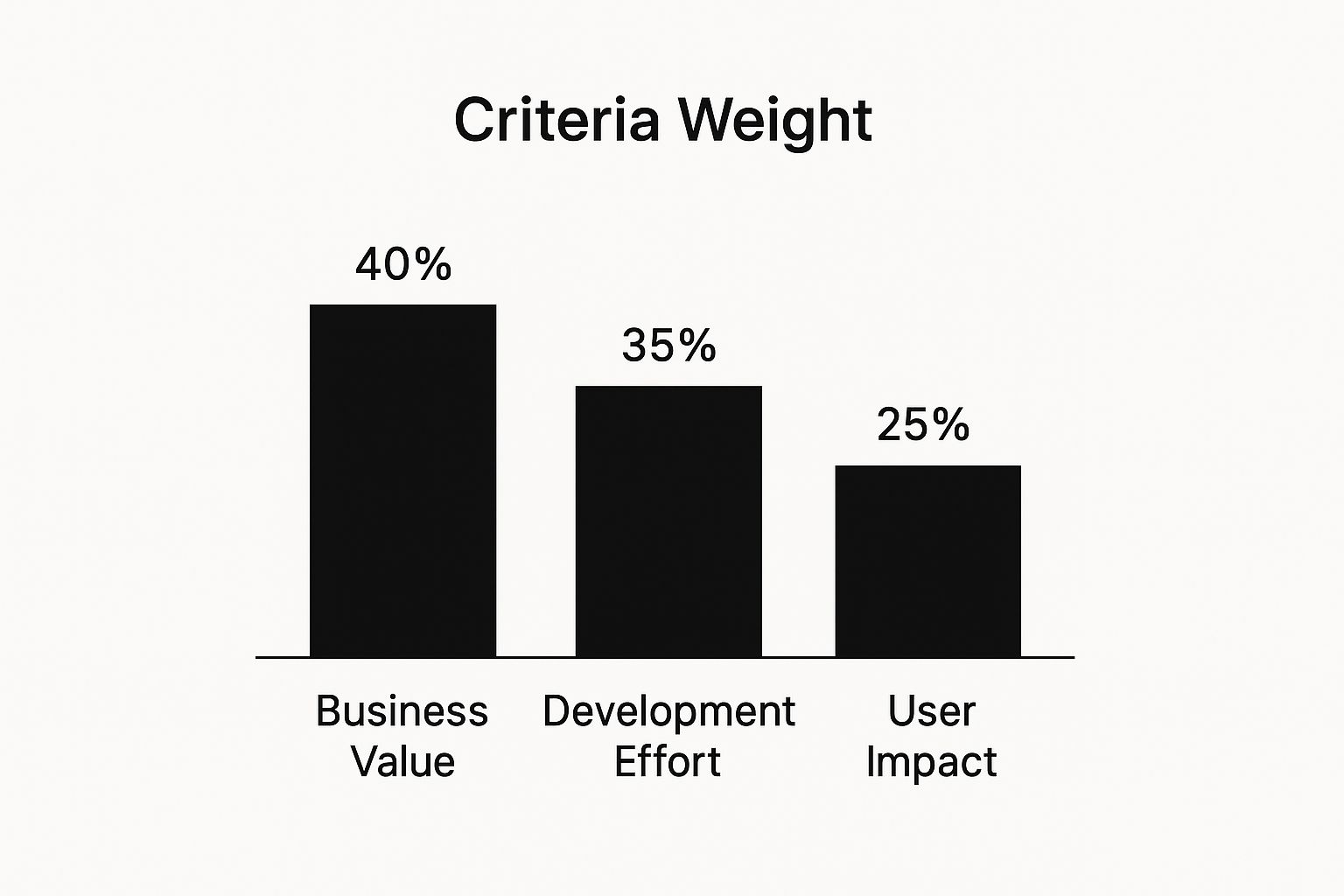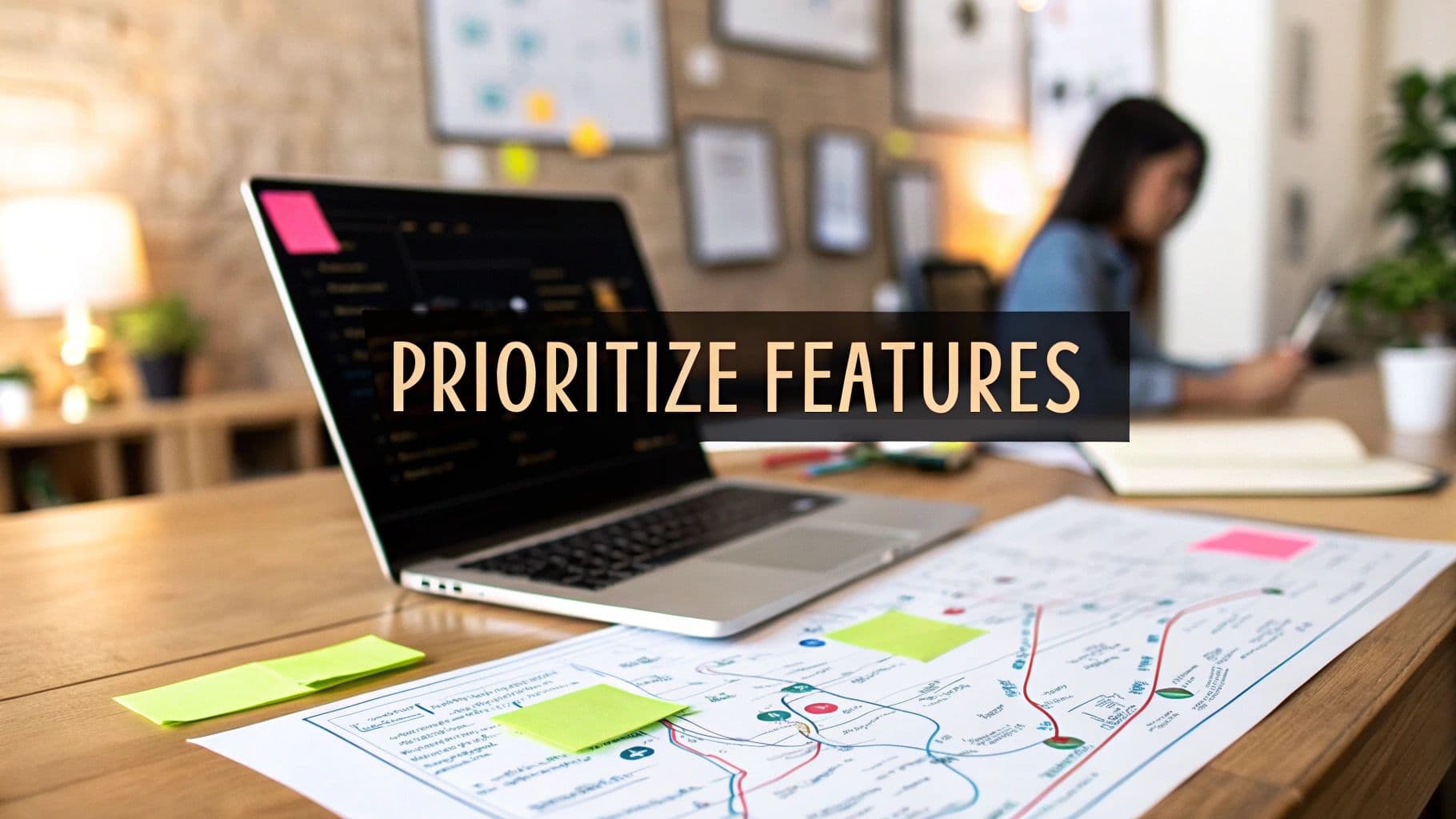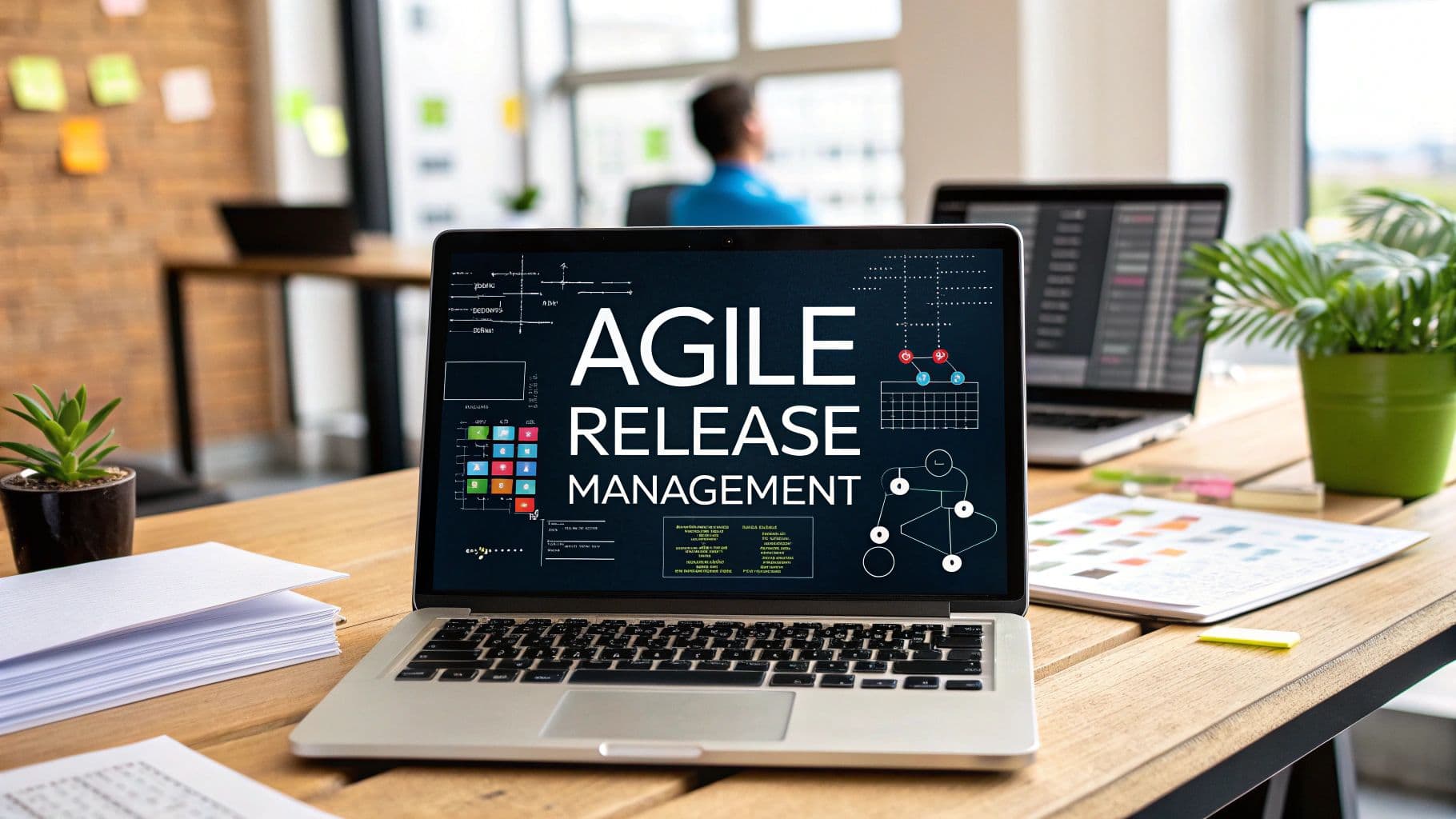how to prioritize product features
product management
feature prioritization
RICE framework
product strategy
How to Prioritize Product Features: Expert Tips & Strategies
Why Most Feature Prioritization Approaches Fail Spectacularly
Let’s be honest for a moment. If your feature prioritization process feels like a constant tug-of-war, you're not alone. In many companies, the roadmap is decided by the loudest voice in the room. It’s a scene many of us know all too well: the sales team is adamant about a niche feature needed to close a massive deal, while engineering is pleading to clean up technical debt that's grinding development to a halt. Meanwhile, the actual users—the people the product is meant for—are nowhere in the conversation.
This reactive, disorganized method is precisely where most teams stumble. Without a clear framework for how to prioritize product features, you stop making strategic choices and start just putting out fires. The "HiPPO" (Highest Paid Person's Opinion) effect takes charge, turning your product backlog into a scrapbook of pet projects instead of a strategic plan for growth. This is a surefire way to build a bloated product that doesn't really serve anyone well.
The Hidden Costs of Guesswork
The fallout from poor prioritization goes much deeper than just building the wrong features. It's a huge drain on your team's morale and your company's resources. When engineers pour months into a feature that gets zero traction, it's incredibly disheartening. This constant chase after shiny objects leads directly to team burnout, causing talented developers and product managers to look for new opportunities where their hard work will actually make an impact.
Beyond the internal chaos, there are significant external costs. Every development cycle you spend on a low-impact feature is an opportunity your competitors are seizing. While you're building something based on a whim, they're methodically solving real customer problems and eating up market share. The hard truth is that many teams are simply guessing. In fact, a staggering 49% of product teams admit they don't know how to prioritize features without direct customer input, leaving them exposed to internal politics and bad assumptions. You can dive deeper into these issues by exploring these insights on product prioritization frameworks.
Psychological Traps That Derail Decisions
Even the most experienced product managers can fall for common psychological biases that throw prioritization efforts off course. We're all human, and these mental shortcuts are easy traps to fall into:
- Confirmation Bias: This is our tendency to look for data that supports what we already believe about a feature’s importance, while conveniently ignoring any evidence to the contrary.
- The Sunk Cost Fallacy: We keep pouring time and money into a feature we know is underperforming, just because we've already invested so much in it. "We can't stop now!" becomes the mantra.
- The Focusing Illusion: We blow a problem's importance out of proportion simply because it's top-of-mind at the moment. This often leads to prioritizing small annoyances over foundational, critical needs.
Setting Up a Prioritization Foundation That Actually Works
Jumping into fancy prioritization frameworks without a solid plan is a bit like trying to build a house on quicksand. Before you can have a meaningful debate about which features to build next, you have to set the ground rules. This prep work is often skipped, but it's what separates teams that nail their priorities from those constantly chasing the next shiny object. It all starts with having crystal-clear product goals.

This chart from Productboard shows how different frameworks connect to various product goals, from boosting user satisfaction to driving business value. Having specific, measurable goals—like "increase user retention by 15%" or "cut down on onboarding friction"—gives you a North Star for every decision.
From Vague Ideas to Clear Objectives
Your goals can't be fluffy corporate-speak; they need to be concrete and something you can actually measure. For instance, instead of aiming to "improve the user experience," a much stronger objective is to "decrease support tickets related to user navigation by 25% in Q3." This specificity turns a vague wish into a direct target that sharpens your decision-making. When a new feature request lands on your plate, the first question should always be, "How does this directly help us hit our main objectives?"
With clear goals established, you need to get a handle on the constant stream of ideas, requests, and feedback. Without a system, you'll drown in a sea of suggestions. This doesn't require a complicated tool; a simple shared document or a project board can work perfectly. The secret is consistency. For every idea, you should capture:
- The Source: Who asked for it? Was it a key customer, the sales team, or an internal stakeholder?
- The "Why": What is the real problem they're trying to solve with this feature?
- The Goal Alignment: Which of our product goals does this idea support?
This simple documentation habit forces everyone to think more clearly and helps you graduate from a chaotic wishlist to a well-managed backlog. It's a key part of good backlog hygiene. For more advice on this, our guide on backlog refinement best practices has some great strategies to keep everything tidy.
Aligning the Humans Behind the Features
Once your goals are set and you have a system for tracking ideas, you need to get everyone on the same page. Product prioritization is as much about people as it is about the product itself. Schedule regular meetings with people from different teams—not to decide what to build, but to make sure everyone understands the why behind your focus. Be open about your documented goals and the logic behind your priorities. This transparency is your best tool against stakeholder pressure and ensures the "squeaky wheel" doesn't get all the attention.
Once you have a firm grasp of your product vision, you can move on to creating a comprehensive startup product roadmap that turns your prioritized features into a concrete plan. This foundation—built on clear goals, organized feedback, and team alignment—guarantees that when you finally pick a prioritization framework, you're using it to execute a solid strategy, not just to bring order to chaos.
Frameworks That Work Beyond the PowerPoint Slides
Once you have your goals and user needs mapped out, it's time to bring in the frameworks that actually work in the real world. These are the tried-and-true methods that add a layer of structure and objectivity to your decisions. They help you answer the core question of how to prioritize product features with data, moving your team's conversations from "I think" to "we know."
The goal is to get everyone aligned and focused on what will make the biggest difference. The infographic below shows a common way teams weigh different factors when prioritizing, creating a balance between business goals, user happiness, and development realities.

This visual shows that no single factor gets to call all the shots. Instead, prioritization is a strategic mix of what’s good for the business, what users will love, and what’s actually feasible for your team to build right now.
The RICE Scoring Method
If your team appreciates a numbers-driven approach, the RICE scoring model is a fantastic tool. Developed by the product team at Intercom, it forces you to think critically about four specific factors for every feature idea:
- Reach: How many people will this feature touch in a given period? (e.g., 5,000 customers per month)
- Impact: How much will this feature move the needle for an individual user? This is usually rated on a simple scale (e.g., 3 for massive impact, 2 for high, 1 for medium, 0.5 for low, and 0.25 for minimal).
- Confidence: How sure are you about your Reach and Impact numbers? Express this as a percentage (e.g., 100% for high confidence, 80% for medium, 50% for low).
- Effort: How much time will this require from your product, design, and engineering teams? This is typically measured in "person-months" (e.g., 4 person-months for a significant project).
The RICE score is calculated with a simple formula: (Reach x Impact x Confidence) / Effort. This equation lets you compare completely different types of features on a level playing field. A high-reach, low-impact feature can be objectively weighed against a low-reach, high-impact one, stripping much of the emotion out of the debate.
The MoSCoW Method
When you need to bring clarity and get quick alignment, especially with stakeholders who aren't in the technical weeds every day, the MoSCoW method is your best friend. It’s all about sorting features into four straightforward categories:
- Must-Haves: These are the absolute non-negotiables. Without them, the product is either broken or simply not viable for the upcoming release.
- Should-Haves: These are important features that add major value but aren't critical for the initial launch. Think of them as the next priority once the "Must-Haves" are handled.
- Could-Haves: These are the "nice-to-have" features. They’re desirable but not essential and will only be tackled if time and resources allow.
- Won't-Haves: These are features that have been explicitly ruled out for the current release cycle. This is crucial for managing expectations and preventing scope creep.
The MoSCoW framework is less about complex calculations and more about creating a shared language around what's truly essential. It’s incredibly effective for setting clear expectations for a specific product release or sprint. It's just one of many feature prioritization frameworks that have become essential for modern product teams. To explore more examples and see how others approach this, you can check out these insights on feature prioritization from Userpilot.
To help you decide which framework might be the best fit for your team's situation, we've put together a comparison table outlining their key differences.
Comparison of Popular Feature Prioritization Frameworks
A comprehensive comparison of RICE, MoSCoW, Kano, and Value vs Effort frameworks showing their strengths, use cases, and implementation complexity.
| Framework | Best Use Case | Time Investment | Data Requirements | Team Size |
|---|---|---|---|---|
| RICE | When you need an objective, data-informed score to compare diverse features. | Medium | Requires quantitative estimates for Reach, Impact, and Effort. | Best for data-savvy teams of any size. |
| MoSCoW | Setting clear expectations for a specific release or sprint with mixed stakeholders. | Low | Based on team consensus and strategic alignment, less on hard data. | Works well with any team size, great for non-technical members. |
| Kano Model | Understanding how features impact customer satisfaction and discovering "delight" features. | High | Needs detailed customer surveys and analysis. | Best for dedicated product research teams or those with user research resources. |
| Value vs. Effort | Quick, visual prioritization to get a high-level view of your backlog. | Low | High-level estimates of value and effort based on team expertise. | Ideal for smaller teams or early-stage planning. |
This table shows that there's no single "best" framework—the right choice depends on your team's culture, the data you have available, and what you're trying to achieve in the short term. Whether you need a quick visual sort or a detailed quantitative analysis, one of these methods can help bring order to your feature backlog.
Getting Customer Insights That Actually Matter

Smart feature prioritization runs on one fuel: genuine customer insight. The trouble is, many product teams think they're collecting useful feedback when they're really just gathering surface-level requests or confirming their own biases. To truly understand how to prioritize product features, you have to learn to see the difference between what users say they want and what they actually need. This means digging deeper than feature wishlists to find the core problems your customers are struggling with.
The most common trap is listening only to your loudest customers. While these power users can offer great perspectives, their needs often don't reflect the silent majority. If you only listen to them, you risk building niche features that confuse or alienate your average user. The key is to balance quantitative data from user analytics with qualitative feedback from a diverse group of customers. Using effective customer feedback survey templates can help you organize this process and make sure you're gathering the right kind of information.
Balancing Vocal Users with Hidden Needs
A powerful way to find those hidden needs is by analyzing user behavior data. Where are people getting stuck? Which features do they start using but never finish? These patterns often point to major pain points that users might not even know how to describe. For instance, you might see that 90% of users abandon a specific configuration screen. That’s a huge red flag signaling a high-priority problem, even if no one has officially complained about it.
This focus on real-time data isn't just for tech companies anymore. Industrial manufacturers are now adopting these customer-focused strategies to improve their product cycles, shifting from rigid plans to more flexible development based on actual usage. This approach is helping them drive innovation and satisfaction in industries that traditionally move much slower. You can explore how industrial manufacturers are borrowing these strategies from tech giants.
Turning Feedback into Actionable Criteria
Gathering insights is only half the job; you need a system to make sense of it all. Feedback scattered across emails and support tickets is practically useless until it's organized. When you structure your feedback process, you can turn random comments into clear criteria for your prioritization framework. If you're looking for a structured way to get started, you might find our guide on how to collect customer feedback helpful. This ensures every feature decision is backed by a solid understanding of customer problems, not just stakeholder opinions, giving you a roadmap that's both defensible and focused on the user.
Surviving the Politics and Stakeholder Chaos
Let's talk about the elephant in the room. Knowing all the fancy frameworks for prioritizing product features is only half the job. The other half is wading through the often messy, sometimes chaotic world of stakeholder politics. Even a perfectly calculated RICE score can get steamrolled by a single, forceful "suggestion" from a powerful executive. This is where your people skills become just as critical as your technical ones.
The simple truth is that different departments have different, and often competing, goals. The sales team wants features that will help them close deals right now. Marketing is looking for something splashy to create a buzz. Meanwhile, the leadership team might be focused on a long-term strategic play that won't show immediate returns. Your role is to act as the objective filter, making sure all these requests align with the core product goals you've worked so hard to establish. This means you have to get comfortable saying "no"—or, more tactfully, "not now."
From Demands to Decisions
We’ve all been there. An executive swoops in with a "genius idea" they had in the shower, fully expecting it to jump to the front of the line. Your reaction here is key. A flat-out "no" can create friction and make you look like a roadblock. A better approach is to gently guide the conversation back to the strategy everyone already agreed on.
Here’s a script I've found useful in these situations. Feel free to adapt it:
"That's a really interesting angle, and I can definitely see the potential. To help the team and I figure out where this fits in, could you help me connect it to our main objectives for this quarter? For instance, would this have the biggest impact on our goal to increase Q3 retention by 15%, or would it help more with reducing onboarding friction? Knowing that will help us slot it in correctly."
This small shift in language changes everything. It turns a top-down demand into a collaborative discussion. You're inviting the stakeholder to think like a product manager and consider the strategic trade-offs. You're not shutting down their idea; you're simply asking them to place it within the established prioritization process.
Turning Stakeholders into Allies
Building consensus isn’t about getting everyone to agree with your every decision. It's about getting them to trust the process you're using to make those decisions. Be transparent. Regularly share your prioritization framework, the data you're using, and the "why" behind your choices. When stakeholders see that decisions are based on objective criteria, not just your gut feeling, they're far more likely to get on board—even when their favorite feature doesn't make the cut this time around.
To keep communication clear and expectations managed, it helps to have a plan for how you talk to different groups. A simple communication matrix can make a world of difference.
Stakeholder Communication Matrix for Feature Decisions
A practical guide showing different communication approaches for various stakeholder types when sharing prioritization decisions.
| Stakeholder Type | Communication Style | Key Information | Frequency | Format |
|---|---|---|---|---|
| Executive Team | Strategic & High-Level | Alignment with business goals, ROI projections, major risks, progress on key initiatives. | Monthly/Quarterly | Exec summary, dashboard, brief presentation. |
| Sales Team | Outcome-Focused | What's coming next that helps them sell, expected release dates, key talking points. | Bi-weekly/Monthly | Sales enablement doc, quick sync, Slack update. |
| Engineering Team | Detailed & Technical | Prioritized backlog, clear user stories, technical requirements, the "why" behind features. | Daily/Weekly | Stand-ups, sprint planning, detailed tickets in Jira. |
| Customer Support | Proactive & Empathetic | Upcoming changes that will affect users, bug fix timelines, new feature walkthroughs. | Weekly | Team meeting, internal knowledge base update. |
| Marketing Team | Narrative-Driven | Big features for campaigns, launch timelines, unique value propositions. | As needed per launch | Kick-off meetings, shared marketing briefs. |
This table shows that you don't need to give everyone the same firehose of information. By tailoring your message, you give each group what they need to feel informed and respected.
Ultimately, this level of transparency is what turns demanding stakeholders into informed allies. They start to appreciate the tough trade-offs you have to make every single day. For a deeper look at managing these complex relationships, this PMP® Stakeholder Management tutorial offers some great insights into navigating organizational dynamics.
Making Your Prioritization Process Stick Long-Term
Picking a shiny new framework like RICE or MoSCoW is often the easy part. The real test of knowing how to prioritize product features comes when the pressure is on. A well-thought-out system can crumble the moment an "urgent" request from leadership lands in your lap or a key competitor rolls out something new. Long-term success isn't about the framework itself, but about the discipline and habits your team builds around it.
This is where so many product teams get tripped up. They put in the work to set up a system but don't fully bake it into their daily routines. To sidestep this common pitfall, you need to start treating your prioritization process like a product: monitor it, gather feedback, and constantly improve it.
From Theory to Reality: Embedding the Process
Introducing a new prioritization method shouldn't feel like a major disruption. It’s better to roll it out gradually. Instead of trying to re-prioritize your entire backlog overnight, start by applying the new framework to a small batch of feature ideas. This lets the team get comfortable with the mechanics without bringing everything to a halt. For example, you could guide your next sprint planning discussion using the Value vs. Effort matrix.
To make the process resilient, documentation is your best friend. Every single prioritization decision needs a clear audit trail. Why did we choose Feature A over Feature B? What data supported that choice? Who was in the room when the decision was made? This creates a "why" log that becomes incredibly valuable for several reasons:
- It gets new team members up to speed quickly by providing essential context.
- It serves as a concrete reference point when stakeholders question past decisions.
- It lets you look back and analyze whether your prioritization choices actually produced the results you hoped for.
Measuring and Evolving Your Approach
Your process shouldn't be set in stone. The objective is to continuously get better at how you make decisions. A fantastic way to do this is to hold a "prioritization retrospective" every quarter. During this meeting, ask your team some pointed questions:
- Did the top-priority features from last quarter actually deliver the value we expected?
- Where were our estimations (for either effort or impact) off the mark?
- Are we spending too much time debating priorities and not enough time shipping features?
This feedback loop helps you sharpen your system based on real-world experience. By treating your prioritization framework as a living process—one that you consistently use, document, and improve—you turn it from a theoretical exercise into a durable advantage that withstands team changes and market shifts.
Your Feature Prioritization Action Plan
Theory is one thing, but turning it into a repeatable, effective process is where the real work begins. Building a solid system for how to prioritize product features involves creating a clear implementation roadmap, setting achievable expectations, and bracing for the inevitable bumps you'll hit. The aim is to shift from making chaotic, one-off decisions to establishing a predictable rhythm that produces real business results.
Timelines and Success Metrics
Don’t expect perfection overnight. A realistic timeline for fully embedding a new prioritization process is typically one to two quarters. During this period, prioritize consistency over speed. The main measure of success isn't how many features you ship, but how well your choices actually support your core objectives.
To see if your new process is working, keep an eye on these key indicators:
- Decision Velocity: How quickly can you get a feature idea from the initial proposal to a firm "yes" or "no"? This should get faster over time.
- Goal Alignment Rate: What percentage of your shipped features can be directly linked to a specific, measurable company goal, like "increase user retention by 5%"? You should be aiming for over 80%.
- Feature Adoption: Are people actually using the new features you’re pushing out? Check your adoption rates 30-60 days after launch to see if your bets paid off.
Avoiding Common Implementation Pitfalls
Even the most well-thought-out plans can go off track. A common pitfall I’ve seen is “framework fatigue,” where the team gets so bogged down in the process that they forget the point is to make decisions. To dodge this, keep your system as simple as you can. It’s far better to consistently use a simple Value vs. Effort matrix than to struggle with a complicated weighted scoring model nobody uses.
Another trap is poor documentation. If you don't have a clear record of why a decision was made, you'll end up having the same arguments over and over. A structured sample product requirements document can be a fantastic template for capturing this essential context. By thinking about these challenges ahead of time, you can build a more resilient and effective prioritization engine.
Ready to stop guessing and start building what matters? The AnotherWrapper AI starter kit gives you the foundation to launch your SaaS project fast, letting you focus on prioritizing features that delight users, not just reinventing the wheel.
Fekri




